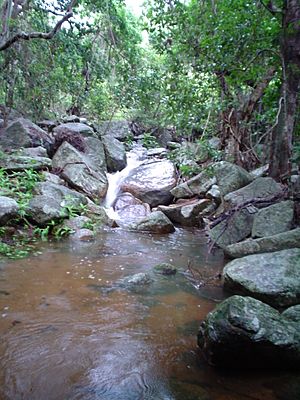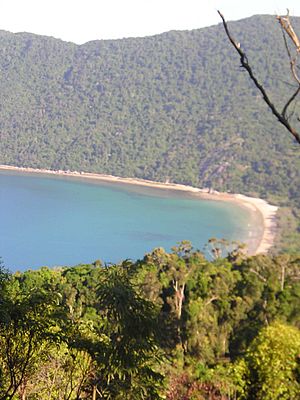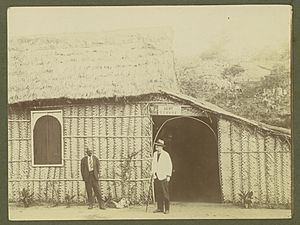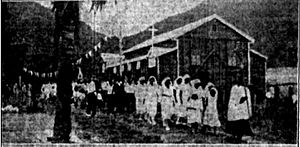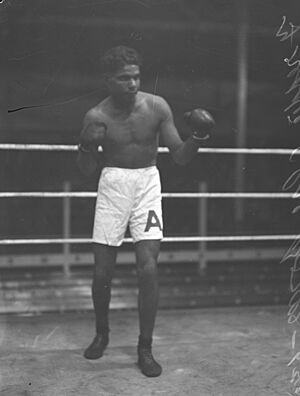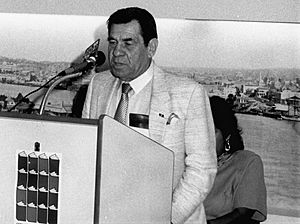Palm Island, Queensland facts for kids
Quick facts for kids Palm IslandQueensland |
|
|---|---|

Palm Islands group, showing Townsville to the south
|
|
| Population | 2,138 (2021 census) |
| • Density | 3.3297/km2 (8.624/sq mi) |
| Postcode(s) | 4816 |
| Area | 642.1 km2 (247.9 sq mi) |
| Time zone | AEST (UTC+10:00) |
| LGA(s) |
|
| State electorate(s) | Townsville |
| Federal Division(s) | Herbert |
Palm Island is a group of 16 islands located in Queensland, Australia. These islands are split between two local government areas: the Shire of Hinchinbrook and the Aboriginal Shire of Palm Island. The name "Palm Island" can refer to the whole group of islands.
However, "Palm Island" is most often used to talk about Great Palm Island. This is the largest island in the group and the only one where many people live permanently. Most of these residents are Aboriginal people. The island is also known as "Bwgcolman". This name means "one people from many groups". It comes from an Aboriginal language spoken by some of the first Aboriginal people who were moved to the island starting in 1918. At that time, it was used as an Aboriginal reserve.
While "Palm Island" can mean the whole group or the Aboriginal Shire, most of the other islands are not lived on. So, when people say "Palm Island", they usually mean Great Palm Island or the local council that governs it.
One of the islands, Orpheus Island, has a special tourist resort and a research center. It is the only island in the group with a well-developed tourism industry.
In the 2021 census, the Palm Island area had a population of 2,138 people. Out of these, 1,918 people (almost 90%) identify as Indigenous Australians.
Contents
Exploring the Palm Island Geography

The Greater Palm group is made up of 16 islands. Twelve of these islands have names. The islands are listed from north to south:
- Pelorus Island (also called North Palm Island, Yanooa, Guyroogarrie) – This island is not lived on and is privately owned.
- Orpheus Island (Goolboddi) – This island has a national park, a research center, and a tourist resort. It is privately owned.
- Albino Rock is a part of Orpheus Island National Park.
- Curacoa Island (Noogoo or Inoogoo)
- Fantome Island (Eumilli)
- Great Palm Island (Bwgcolman)
- Esk Island (Soopun)
- Falcon Island (Carbooroo)
- Eclipse Island (Garoogubbee)
- Brisk Island (Culgarul)
- Barber Island (Boodthean)
- Fly Island
- Havannah Island
The group was first named the "Palm Isles" by explorer James Cook. Today, it's also called the Palm Island group or the Greater Palm group. Most of these islands are very small. The most important ones are Great Palm Island (the biggest, with people living there), Fantome Island, and Orpheus Island.
The ocean around these islands is part of the Great Barrier Reef Marine Park. This means that fishing and taking things from the sea are carefully controlled to protect the reef. Nearby islands not in the Palm group include Rattlesnake Island, which the Air Force uses for practice, and Magnetic Island, which is a suburb of Townsville. The closest reef to the group is Pandora Reef.
Table 1 shows the very small islands, called rocks, and their special names from the Great Barrier Reef Marine Park Authority (GBRMPA).
| Island name | GBRMPA reef designation |
|---|---|
| Paluma Rock | 18-056 |
| Albino Rock (AKA White Rock) | 18-057 |
| Dido Rock | 18-060 |
| Chilcott Rocks | 18-063 |
| Hayman Rock. | <none> |
The Bwgcolman People: Origins and History
The people living on Palm Island today are descendants of those who were brought to the Palm Island Aboriginal Settlement. This happened between 1914 and 1971. Many different Aboriginal groups are part of the Bwgcolman people, possibly as many as 57 different language groups.
At least 5,000 people were forcibly moved to the reserve from all over Queensland, the Torres Strait, and Melanesian islands. Most of the current population comes from people who lived between Bowen and Tully, from north-western Queensland, and from the Cape York Peninsula.
How Palm Island is Governed
The Palm Island area is part of the federal Division of Herbert and the state Electoral district of Townsville.
The islands are governed by different local councils. The two northernmost islands, Pelorus and Orpheus, are in the Shire of Hinchinbrook. The other ten islands are part of the Aboriginal Shire of Palm Island. Table 2 shows the ten islands that are under the Palm Island Aboriginal Shire Council. The remaining rocks are owned by the Commonwealth and are managed by the Great Barrier Reef Marine Park Authority (GBRMPA).
Australia Post uses one postcode (4816) for the entire Palm Island group. There isn't an official name for the main town on Great Palm Island. The town area, near where the ferries arrive, has schools, shops, a football club, a hospital, and churches. Some locals still call it "the Mission." The Queensland Government calls it "Palm Islands" in its records. There are also smaller settlements north and south of the town, but roads are mostly on the western side of the island.
| Island name | Aboriginal name | Group size | Bushfire risk | GBRMPA reef designation |
|---|---|---|---|---|
| Curra-cao or Curacoa Island | Noogoo or Inoogoo | major | medium | 18-052 |
| Fantome Island | Eumilli | major | medium | 18-053 |
| Great Palm Island or Palm Island | Bwgcolman | major | high | 18-054 |
| Havannah Island | major | medium | 18-065 | |
| Brisk Island | Culgarool | micro-island | medium | shared with Falcon Island |
| Eclipse Island | Garoogubbee | micro-island | not rated | 18-058 |
| Esk Island | Soopun | micro-island | not rated | 18-059 |
| Barber Island | Boodthean | micro-island | not rated | 18-061 |
| Falcon Island | Carbooroo | micro-island | not rated | 18-062 |
| Fly Island | micro-island | not rated | 18-064 |
Palm Island Climate
The Palm Islands are located in a tropical zone. This means they have a tropical climate and can be affected by cyclones.
Palm Island History
Before European Contact
The Manbarra people are the traditional owners of Great Palm Island and the nearby islands. In Manbarra beliefs, the Palm Island group was formed in the Dreamtime. They believe it was made from pieces of an ancestral spirit, the Rainbow Serpent. The Manbarra language (also known as Wulgurukaba) is spoken in the Palm Island region.
In the Hinchinbrook shire, the traditional owners of Orpheus Island were the Nywaigi people. The Warakamai people lived on Hinchinbrook Island.
Explorer James Cook named the islands the "Palm Isles" in 1770. He was sailing along the eastern coast of Australia on his first voyage. It's thought that about 200 Manbarra people lived on the island when Cook visited. Cook sent some of his men to Palm Island, but they "returned on board having met with nothing worth observing."
In 1819, Captain Phillip Parker King landed on one of the islands. He wrote about seeing recently used circular huts and canoes nearby.
History of Great Palm Island
Great Palm Island has always been the most populated island. Around 1770, about 200 people lived there. From the 1850s, some locals were encouraged to leave the island to work in bêche-de-mer (sea cucumber) and pearling businesses with Europeans and Japanese. By the late 1800s, the population had dropped to about 50 people.
In 1914, the Queensland Government created the Palm Island Aboriginal Settlement. From 1918, people were moved there from all over Queensland. This started with residents from the Hull River Aboriginal Settlement after a cyclone destroyed their mission. People from up to 57 different language groups were moved to Palm Island. In the first 20 years, the number of residents grew from 200 to 1,630. It was seen as a place where people were sent for perceived wrongdoings. It quickly became the largest government Aboriginal reserve in Queensland.
The first St George's Anglican Church was built in 1931 using palm leaves and grass. On July 4, 1935, a new wooden St George's Anglican Church was opened.
During World War II, the Naval Air Station Palm Island (also known as Palm Island Airfield) was built in 1943. The US Navy built it at Wallaby Point. It was a place to maintain seaplanes, especially PBY Catalina flying boats.
St Anthony's Catholic Church was opened on August 6, 1961. It was designed and built from stone by engineers from Townsville. It is located at 26 Banfield Drive, within the Catholic school grounds.
The dormitories for women closed in 1967 and were taken down in 1969. The dormitories for children officially closed on December 5, 1975.
1978: Changes to the Aboriginal Council
In July 1978, the Aboriginal Council of Palm Island was removed by the government led by Joh Bjelke-Petersen. This happened after the Queensland Government wanted to give control of Palm Island to the Townsville Council. The islanders were against this idea and signed a petition. A newspaper reported that the government's decision was based on a counter-petition that had many forged signatures. The report said this was part of a plan to open the island for property and tourist development.
1999: Compensation for Underpaid Wages
In 1999, the Queensland Government said sorry and paid $7,000 to each former Palm Islander employee. This was to make up for underpaid wages between 1975 and 1986. This payment was ordered by the Human Rights and Equal Opportunity Commission. The case was first brought to the commission by seven Palm Islanders in 1986.
2004: Important Legal Outcomes
In November 2004, a Palm Island resident passed away in a police cell. After a report showed severe internal injuries, some protests occurred. Later, a police officer was tried but found not guilty.
In December 2016, a court found that police actions after the protests had broken the Racial Discrimination Act 1975. In May 2018, a large settlement of $30 million was given to the victims. The court said the police actions were "racist" and "unnecessary" because they were dealing with an Aboriginal community.
Fantome Island Medical Facilities (1926–1973)
In 1926, a special hospital was built on Fantome Island. By 1937, Fantome Island became a medical station. Aboriginal people sent to Palm Island were checked and treated there if needed. A place for people with leprosy was also set up on Fantome Island in 1939.
The hospital closed in 1945, and the leprosy facility closed in 1973. The people living there were then moved to Great Palm Island.
2004: Legal Action about Pearl Farming
Two companies, Zen Pearls Pty Ltd and Indian Pacific Pearls Pty Ltd, started pearl farms in 1998. They had permission from the Great Barrier Reef Marine Park Authority, which manages the waters around the islands. However, some people on Palm Island were against these farms.
Later, the Park Authority refused to let the pearl farms continue. The company took legal action, but in March 2004, a court agreed that the permits should end. The farms were allowed to continue until December 1, 2005. This decision was mostly supported by the Federal Court in October 2004.
Palm Island Community and People
In the 2016 census, Palm Island had 2,455 residents. About 74.5% identified as Australian Aboriginal, and 12.8% identified as Torres Strait Islander.
The Indigenous people living there usually identify as either Bwgcolman (descendants of Aboriginal and Torres Strait Islander people moved to Palm Island) or Manbarra (the original inhabitants). As of 2007, the community included about 42 different Aboriginal Australian and Torres Strait Islander family groups.
The Palm Island community is younger than the rest of Australia. About 32% of people are under 15, and only 3.3% are over 64. The community is also more religious. The most common religions were Catholic (50.4%), Anglican (19.4%), and other Christian groups. Only 8.1% reported no religion.
Most people (92.2%) reported speaking only English at home. A small number (0.2%) spoke Yumplatok (Torres Strait Creole).
In 2016, 702 people were in the workforce. About 38.6% worked full-time, 28.3% worked part-time, and 29.1% were unemployed. The average weekly income for people aged 15 and over was $306. Most homes (93.8%) were rented. The level of education was generally lower than in Queensland as a whole, with very few people having university or college qualifications.
In the 2021 census, the population of Palm Island was 2,138 people. Of these, 1,918 (89.7%) identified as Indigenous Australians.
Education on Palm Island
Palm Island Settlement State School opened in 1926 but closed in 1927. A mission school operated on the island in the 1930s. In 1962, Palm Island Settlement School opened again. It was later renamed Palm Island State School, and in 1994, it became Bwgcolman Community School.
The Sisters of Our Lady Help of Christians started St Michael's Catholic Convent in 1934. They opened a temporary Catholic school in October 1934 with 97 students. However, they didn't have enough money for a permanent school until 1938. St Michael's Catholic School was officially opened on July 24, 1938. In 1945, the Franciscan Missionaries of Mary took over from the Sisters of Our Lady Help of Christians. In 1969, the school was moved because it was in the way of airport development. From 1979 to 1991, the school was run by non-religious Catholic leaders. Then, the Sisters of the Good Samaritan took over in 1992.
Palm Island Provisional School opened in 1938 for the children of the white officials on the island. It closed in 1970.
As of 2022, there are two schools on Great Palm Island:
- Bwgcolman Community School is a school for Indigenous children from early childhood to Year 12. It is located on Creek Road. In 2018, it had 249 students and a special education program.
- St Michael's Catholic School is a Catholic primary school for students from Prep to Year 6. It is located on Banfield Highway. In 2018, it had 101 students.
The Bwgcolman Indigenous Knowledge Centre (IKC) is run by the Palm Island Aboriginal Shire Council. It's a community space that combines library services with training, learning, and information activities. The IKC helps people access information, knowledge, and culture. It also helps community members take part in social and economic opportunities. The IKC is very important as a historical information center. It connects local people and visitors with historical records and family history.
Getting Around: Transport on Palm Island
Sealink Queensland runs a ferry from Townsville to Great Palm Island every day except Tuesday. The trip takes about an hour and 15 minutes. There is also a daily ferry and barge service from Lucinda. Palm Island Airport is on Great Palm Island and is managed by the local council. Hinterland Aviation has several flights each weekday. Townsville Helicopters offers on-demand helicopter flights to and from Palm Island, also from Townsville Airport.
There is a daily scheduled helicopter flight from Townsville to the luxury resort on Orpheus Island and back. Private helicopter charter flights can also be arranged from Townsville, Cairns, or other nearby places.
Tourism on Palm Island
In the Palm Island area, only Orpheus Island has a well-developed tourist industry. This is centered around a private luxury resort called the Orpheus Island Lodge.
Some efforts have been made to develop tourism on Great Palm Island. The island has tropical rainforest and many different plants and animals. It is also close to the Great Barrier Reef and its waters are full of tropical fish. This makes it a great place for eco-tourism. However, there have been concerns because of the island's difficult history and social challenges. The residents need to be ready for many visitors. Still, there are some places for tourists to stay and things to do on Great Palm Island, like Klub Kuda. The Palm Island Motel is run by the council.
Notable People from Palm Island
Iris and Freddie Clay
Iris Clay (1936–1979) and her husband Frederick William (Fred, or Freddie) Clay (1927–1983) were important Indigenous leaders and activists. They worked hard for equality for the people of Palm Island. Iris worked for the Aboriginal Legal Service on Palm Island. She also helped start and was a director of Aboriginal Hostels Limited.
Freddie and Iris Clay were moved to Palm Island in 1935 from Cloncurry. When he was 15, Fred escaped to the mainland. He made it to Ingham before being caught and returned to the reserve. Fred became a boxer around 1950. He was an activist by 1969, at a time when Aboriginal people were not allowed on the main street.
Clay Street in the suburb of Bonner, Australian Capital Territory, was named in honor of Iris and Fred Clay in 2009. In 2014, the Frederick William Clay Park was opened on the foreshore of the town on Palm Island.
Bill Rosser
Bill Rosser (1927–2002) was an author and union organiser. He wrote books like This is Palm Island (1978) and Return to Palm Island (1994). He visited Palm Island in 1974 after being invited by Iris Clay. He was surprised by how much the lives of Aboriginal people were controlled by Queensland laws.
Rosser, Fred Clay, and others started a newsletter called Smoke Signal in 1974. It described the lives of Aboriginal people under the laws at the time. The newsletter ran for at least 12 issues. Clay and Rosser were later forced to leave the island.
Rosser later created another publication for Aboriginal people called Black Knight in Brisbane (1975).




